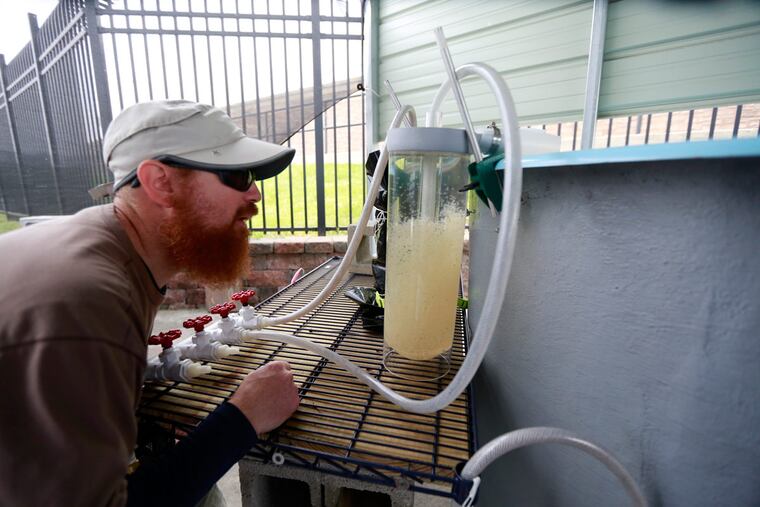Scientists' goal: Make the rare American shad less rare
It is that time of year: time to count the fish. The ones traveling hundreds of miles from far-flung ocean waters. The ones heading upstream in search of a suitable space of riverbed (the Black Rock Dam in Phoenixville is always nice this time of year) to meet that special someone and lay a couple of hundred thousand eggs before leaving town.

It is that time of year: time to count the fish.
The ones traveling hundreds of miles from far-flung ocean waters. The ones heading upstream in search of a suitable space of riverbed (the Black Rock Dam in Phoenixville is always nice this time of year) to meet that special someone and lay a couple of hundred thousand eggs before leaving town.
In these next few weeks, the height of the spawning migration season, the job of counting all the fish passing through town falls to Joe Perillo. He's an aquatic biologist for the Philadelphia Water Department who runs the Fairmount Fish Ladder. That's the series of rising concrete chutes and pools that sit on the banks opposite the Fairmount Water Works. It's how the fish make their passage over the Fairmount Dam.
These days (the spawning season runs from about April to July) Perillo can be found kneeling in front of a wall-sized window in a concrete bunker at the edge of the dam, watching fish dart past. Sometimes in ones and twos and sometimes in packs so thick (30,000 to 50,000 fish pass through the ladder each season) it looks as if they're squeezing through a turnstile. Thankfully, Perillo does not have to count the fish manually. That's how it was done until the 1970s, he said. Video cameras film the fish, and a team of assistants trained by Perillo ticks them off. It takes about a year to count them all.
Passing by Perillo's underwater window are fat striped bass and schools of alewives and blueback herring. There's flathead catfish lurking in the chutes to lazily feast on herring, and there are lumbering carp that push through pooling fish like barroom bullies.
There's the occasional northern snakehead ("a python with fins," Perillo said). And like an old returning friend, there's that butterfly koi, the one with the orange swirls and very human-looking nose that finds its way year after year. Perillo's 7-year-old son has named it "Creamsicle."
But what Perillo and Water Department scientist Lance Butler hope to see most from their window each year is that rare freshwater celeb: the American shad. It's the historic fish that saved Washington's starving troops at Valley Forge and once swelled the Schuylkill to its brim before dams, pollution, and overharvesting made it scarce in Pennsylvania waters.
In recent years, though, cleaner water, a repaired fish ladder, and a state hatchery system have led to some encouraging, if still small, increases in the number of American shad making their way home.
For so long, the fish ladder was in disrepair, crumbling and clogged. By 1999, only a hundred or so American shad were passing through each season. But the American shad have been returning since the Army Corps of Engineers rehabbed the ladder in 2009.
In recent years, Perillo has tracked more than 1,200 American shad every year, with a high of 3,400 in 2011. A nice bump, but still far from the 20,000 to 30,000 they'd like to see passing through. That would represent a real step toward a self-sustaining population - one not reliant on hatchery fish.
"We're in recovery mode," Perillo said, "but we're seeing signs."
This year, Perillo, 40, a native of Roxborough and a University of Tennessee graduate who wears a long red beard and tie-dyed bandanna, is doing something different: He's not only counting the shad - he's making them, in his own hatchery.
After securing some funds for the tanks, Perillo and fellow biologist Steve Ostrowski spent the winter completing their project with salvage parts and help from Water Department maintenance crews.
"Next year, it will be more refined," Perillo said. "This year was a pull-it-all-together year."
And they did.
The spawning tank, which sits on a landing above the fish ladder with the Water Works and skyline behind it, was filled with 62 American shad recently plucked from the river. (Despite a protective iron fence, Perillo recently found a pink fishing lure snagged to one of the hatchery's tables. Some moron had tried to do some fishing in the tank.)
For now, it's a start, Perillo said of his hatchery. He hopes it evolves and becomes a game-changer.
On Friday, the hatching jars were filled with tens of thousands of pearl-sized fertilized eggs. When they hatch into tiny shad fry - "two eyes and a wiggle," Perillo said - they will be released upstream.
The ones that survive will leave Philly to spend most of their lives traversing the Outer Banks and Nova Scotia coasts. Then in five years, they will by memory, by imprint, return to Philadelphia, to the fish ladder, and to Perillo's underwater window, where he will be waiting for them.
mnewall@phillynews.com215-854-2759